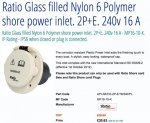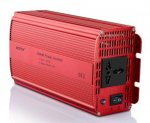Babylon
Well-known member
Presently have an orange shore-power lead that feeds down the hatch to a loose 13A domestic socket with a cheap domestic RCD plugged in, then to a loose 4-gang extension, into which I currently plug a C-TEK 7amp smart charger, plus whatever else is needed at the time (e.g. a small electric kettle, a small oil-filled heater, a fan-heater, laptop, phone-charger, hairdryer, etc).
All this crap of cables and trolling extensions needs to be put away before getting underway, it isn't properly safe, it isn't earthed or isolated, and there is no 240v ring-main to safely distribute power to fixed sockets around the boat. The 7amp smart charger should also really be upgraded to a 15amp unit for the size of my battery bank, and the old 300w modified sine-wave inverter upgraded to a modern 1000w unit before forming part of the ring-main.
Boat is normally kept on a mid-river mooring away from stray currents, has a wind-generator to keep the 2x110Ah domestic bank and the engine-start battery topped up, and the Beta 25 engine has a good 70Amp alternator fitted. The VSR ensures the engine start-battery on its completely independent circuit is always charged first, whatever the source.
So, aside from needing a water-proof flush socket to fit into a cockpit side-locker, an RCD to fit alongside the bigger charger and inverter down below, and cabling and domestic-sockets to run around the cabin, what else do I need? Do I need marine-grade cabling for the ring-main? Where do I earth the RCD to? Will I need to fit a galvanic-isolator and where in the system does this go?
Finally, what is so special about Marinco plugs and sockets - what's wrong with the cheaper normal blue/white kit (except that in rough weather my cockpit side-lockers can fill with green water)?
Cheers
All this crap of cables and trolling extensions needs to be put away before getting underway, it isn't properly safe, it isn't earthed or isolated, and there is no 240v ring-main to safely distribute power to fixed sockets around the boat. The 7amp smart charger should also really be upgraded to a 15amp unit for the size of my battery bank, and the old 300w modified sine-wave inverter upgraded to a modern 1000w unit before forming part of the ring-main.
Boat is normally kept on a mid-river mooring away from stray currents, has a wind-generator to keep the 2x110Ah domestic bank and the engine-start battery topped up, and the Beta 25 engine has a good 70Amp alternator fitted. The VSR ensures the engine start-battery on its completely independent circuit is always charged first, whatever the source.
So, aside from needing a water-proof flush socket to fit into a cockpit side-locker, an RCD to fit alongside the bigger charger and inverter down below, and cabling and domestic-sockets to run around the cabin, what else do I need? Do I need marine-grade cabling for the ring-main? Where do I earth the RCD to? Will I need to fit a galvanic-isolator and where in the system does this go?
Finally, what is so special about Marinco plugs and sockets - what's wrong with the cheaper normal blue/white kit (except that in rough weather my cockpit side-lockers can fill with green water)?
Cheers





